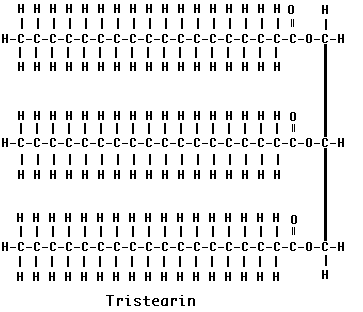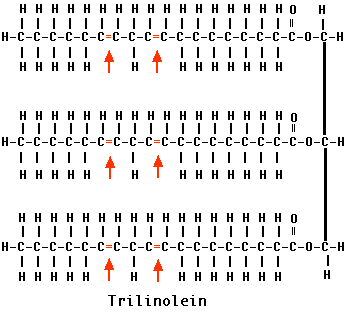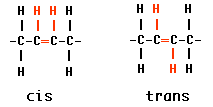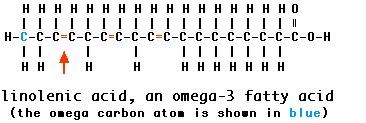 Fat molecules are made up of four parts:
Fat molecules are made up of four parts:
Each fatty acid consists of a hydrocarbon chain with a carboxyl group at one end. The glycerol molecule has three hydroxyl groups, each able to interact with the carboxyl group of a fatty acid. Removal of a water molecule at each of the three positions forms a triglyceride.
In animal fats, 16-carbon (palmitic acid) and 18-carbon (stearic acid - shown here) fatty acids are the most common.
 Some fatty acids have one or more double bonds between their carbon atoms. They are called unsaturated because they could hold more hydrogen atoms than they do.
Some fatty acids have one or more double bonds between their carbon atoms. They are called unsaturated because they could hold more hydrogen atoms than they do.As this list suggests, plant fats tend to be unsaturated (therefore "oils"). Fats from such animals as cattle tend to be saturated.
In hydrogenation, plant oils are exposed to hydrogen at a high temperature and in the presence of a catalyst.
 Two things result:
Two things result:
 One system for naming unsaturated fatty acids is to indicate the position of the first double bond counting from the opposite end from the carboxyl group. That terminal carbon atom (shown here in blue) is called the omega carbon atom. Thus a monounsaturated fatty acid with its single double bond after carbon #3 (counting from and including the omega carbon) is called an omega-3 fatty acid. But so is a polyunsaturated fatty acid, such as linolenic acid (shown here), if its first double bond is in that position.
One system for naming unsaturated fatty acids is to indicate the position of the first double bond counting from the opposite end from the carboxyl group. That terminal carbon atom (shown here in blue) is called the omega carbon atom. Thus a monounsaturated fatty acid with its single double bond after carbon #3 (counting from and including the omega carbon) is called an omega-3 fatty acid. But so is a polyunsaturated fatty acid, such as linolenic acid (shown here), if its first double bond is in that position.
Some studies have suggested that omega-3 fatty acids help protect against cardiovascular disease.
| Link to a discussion of the role of fats in the human diet. |
| Welcome&Next Search |